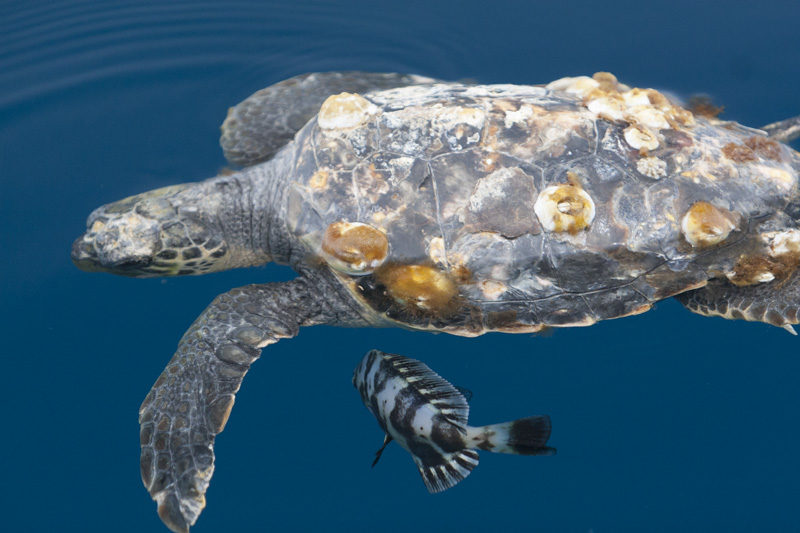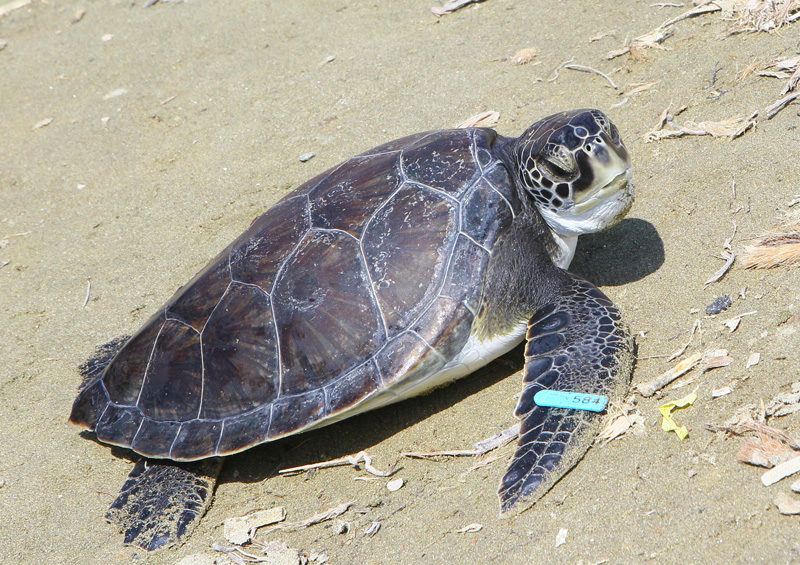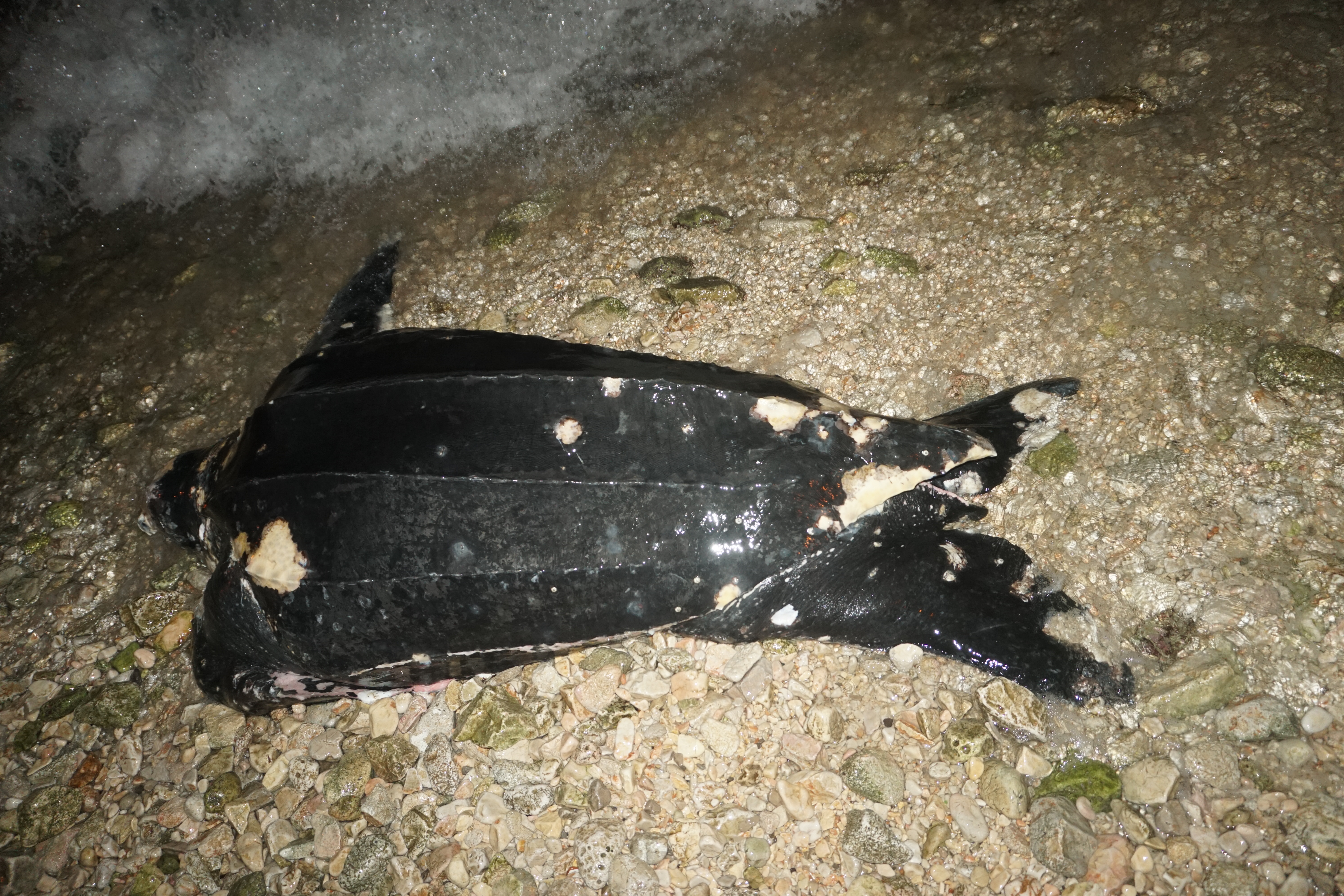3.6. Sea turtle species in the Mediterranean Sea
There are seven species of sea turtles in the world belonging to the taxonomic superfamily Chelonioidea – the flatback (Natator depressus), green (Chelonia mydas), hawksbill (Eretmochelys imbricata), Kemp’s ridley (Lepidochelys kempii), loggerhead (Caretta caretta) and olive ridley (Lepidochelys olivacea) all belong to the family Cheloniidae; the leatherback (Dermochelys coriacea) is the only member of the family Dermochelyidae. The Mediterranean Sea is frequented by three sea turtle species, two of which nest there and once boasted abundant populations: the loggerhead (Caretta caretta) and the green turtle (Chelonia mydas). The leatherback (Dermochelys coriacea) is a rare visitor.
The most common species in the Mediterranean is the loggerhead sea turtle (Caretta caretta). It was named after its large head equipped with strong jaws allowing the animal to break open hard bivalve and crustacean shells. Nesting sites are situated in the tropics and subtropics but it inhabits temperate regions as well. Hatchlings are approximately 25 mm long, while the adults can measure up to 100 cm in length, weighing up to 200 kg. Nesting beaches in the Mediterranean are mostly situated in the eastern part, mainly Greece, Turkey and Cyprus. Most turtles inhabiting the Adriatic come from nesting beaches in Greece, particularly the island Zakynthos.
Loggerhead sea turtles live up to 60 years and are mature when they are 15 to 20 years old. Females return to the sandy beach where they were born to lay between 80 and 120 eggs in one nest. Loggerheads lay three or four nests each season but only every three or four years. A female will return to the sea if disturbed while laying eggs. Egg incubation time until hatching is 55-60 days. The sex of sea turtles is determined by sand temperature: a higher temperature will produce females and the transitional temperature for the loggerhead turtle is 29°C. Upon hatching the little turtles run in the direction of the Moon’s reflection in the sea water. When they are in the water, they swim as fast as possible to reach relative safety of the open sea. It is not fully known how they navigate once in the open sea, but they may follow sea currents, the Earth’s magnetic field, etc. Only about one percent of the hatchlings will reach sexual maturity.

The lost years: Little is known about the life of the loggerhead sea turtle between hatching and returning to lay eggs in the beaches of the Eastern Mediterranean. With more than 60% of the documented nests laid annually in the Mediterranean, the rookeries in Greece account for the largest loggerhead nesting population in the region. Recent recoveries of loggerhead turtles tagged on nesting beaches that have been reported in the northern Adriatic suggest that this area is important for both adult and juvenile loggerheads. Turtle movements into the Adriatic are likely developmental or feeding migrations and there is probably a major migratory pathway from the Ionian Sea into the Adriatic. Repeated recoveries of the same individuals within a particular year indicate that loggerheads reside in the Adriatic for extended periods of time and also indicate a degree of site fidelity. The northern and central Adriatic, together with the Gulf of Gabès in Tunisia, are the two shallowest (less than 200 m deep) regions in the Mediterranean. A high number of tag recoveries coinciding with these two regions suggest that they are important benthic habitats for loggerheads.
The green sea turtle (Chelonia mydas) was named after its green fatty tissue responsible for the overall appearance of the animal. They can grow up to 120 cm in length. Developing juvenile animals feed on invertebrates such as jellyfish and become herbivorous upon reaching sexual maturity, when they feed on algae and seagrass. This happens at an age of 20 to 40 years. This is a widely distributed species. Nesting sites are situated in the tropics but turtles can be found in temperate waters as well. In the Mediterranean it is reported in low numbers (since 1830) but, since it may be confused with the loggerhead turtle, its presence is likely to be underestimated. The green turtle is listed as Endangered. The population inhabiting the Mediterranean is the least numerous and most threatened of all. Nesting beaches are situated mainly on Cyprus and in Turkey, but there are also some in Lebanon, Egypt and Israel.

The leatherback (Dermochelys coriacea) is the largest species of sea turtle with a carapace reaching two metres in length. It can dive up to a 1.000 m deep, more than any other turtle! It can easily be distinguished by the lack of the bony shell, characteristic for other sea turtle species. The skin covered shell allows it to withstand high water pressure. Leatherbacks are the most widely distributed species of sea turtles. It is distributed in waters from Alaska in the north to the Cape of Good Hope in the south. Despite the wide distribution, the leatherback turtle appears rather rare in the area, with 30 individuals recorded in the whole Adriatic since 1894. The leatherback is the only sea turtle species in the Mediterranean without any nesting sites in the basin. Adult animals can be over 180 cm long and weigh 500 kg or more. They feed on gelatinous zooplankton such as jellyfish and salps throughout their entire life.


